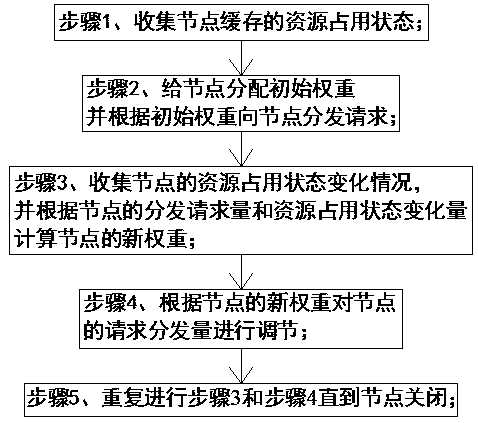Node preheating method based on positive feedback
A positive feedback and node technology, applied in the field of node preheating, can solve the problems that nodes cannot cope with a large number of read operations, increase processing capacity, and fail to respond, so as to avoid node crashes, improve processing capabilities, and avoid suspended animation.
- Summary
- Abstract
- Description
- Claims
- Application Information
AI Technical Summary
Problems solved by technology
Method used
Image
Examples
Embodiment 1
[0037] A node preheating method based on positive feedback in this embodiment includes the following steps:
[0038] Step 1. Collect the resource occupancy status of the node cache;
[0039] Step 2. Assign initial weights to nodes and distribute requests to nodes according to the initial weights;
[0040] Step 3. Collect changes in the resource occupancy state of the node, and calculate the new weight of the node according to the distribution request volume of the node and the change in resource occupancy state;
[0041] Step 4. Adjust the request distribution amount of the node according to the new weight of the node;
[0042] Step 5. Repeat steps 3 and 4 until the node is shut down.
[0043] The scheduling module is responsible for distributing the requests that need to be processed to the nodes. After receiving the requests from the outside, the scheduling module forwards the requests to each node according to the weight ratio of each node. The higher the weight of the no...
Embodiment 2
[0045] This embodiment is further optimized on the basis of embodiment 1, and said step 3 includes the following sub-steps:
[0046] Step 3.1, obtain the initial occupancy state S1 of the resource occupancy state of the node's cache;
[0047] Step 3.2. Calculate the distribution request amount A of the node according to the following formula:
[0048]
[0049] Step 3.3. Obtain the occupancy state S of the node's cache for resources after the node distributes the request 2 , and calculate the amount of change in resource occupancy state △S=S 2 -S 1 ;
[0050] Step 3.4: Obtain the new weight of the node by the ratio of the distribution request amount A to the resource occupation state change amount ΔS.
[0051] The scheduling module obtains the occupancy of resources by the cache module from the node S 1 , and the built-in state collection tool inside the node calls the internal tool of the operating system to collect the information list of the hardware CPU in the node,...
Embodiment 3
[0058] This embodiment is further optimized on the basis of the above-mentioned embodiment 1 or 2, and the sub-steps of assigning initial weights to nodes in the step 2 are as follows:
[0059] Step 2.1, setting the limit value of the node's request increment and load increment;
[0060] Step 2.2, determine the request increment and load increment of the node;
[0061] Step 2.3, if the request increment of the node is greater than the threshold value and the load increment is less than or equal to the threshold value, assign a high weight to the node;
[0062] If the request increment of the node is greater than the threshold value and the load increment is greater than the threshold value, assign a low weight to the node;
[0063] If the request increment of the node is less than or equal to the threshold value and the load increment is less than or equal to the threshold value, the node is assigned a medium weight;
[0064] If the node's request increment is less than or e...
PUM
 Login to View More
Login to View More Abstract
Description
Claims
Application Information
 Login to View More
Login to View More - R&D
- Intellectual Property
- Life Sciences
- Materials
- Tech Scout
- Unparalleled Data Quality
- Higher Quality Content
- 60% Fewer Hallucinations
Browse by: Latest US Patents, China's latest patents, Technical Efficacy Thesaurus, Application Domain, Technology Topic, Popular Technical Reports.
© 2025 PatSnap. All rights reserved.Legal|Privacy policy|Modern Slavery Act Transparency Statement|Sitemap|About US| Contact US: help@patsnap.com



